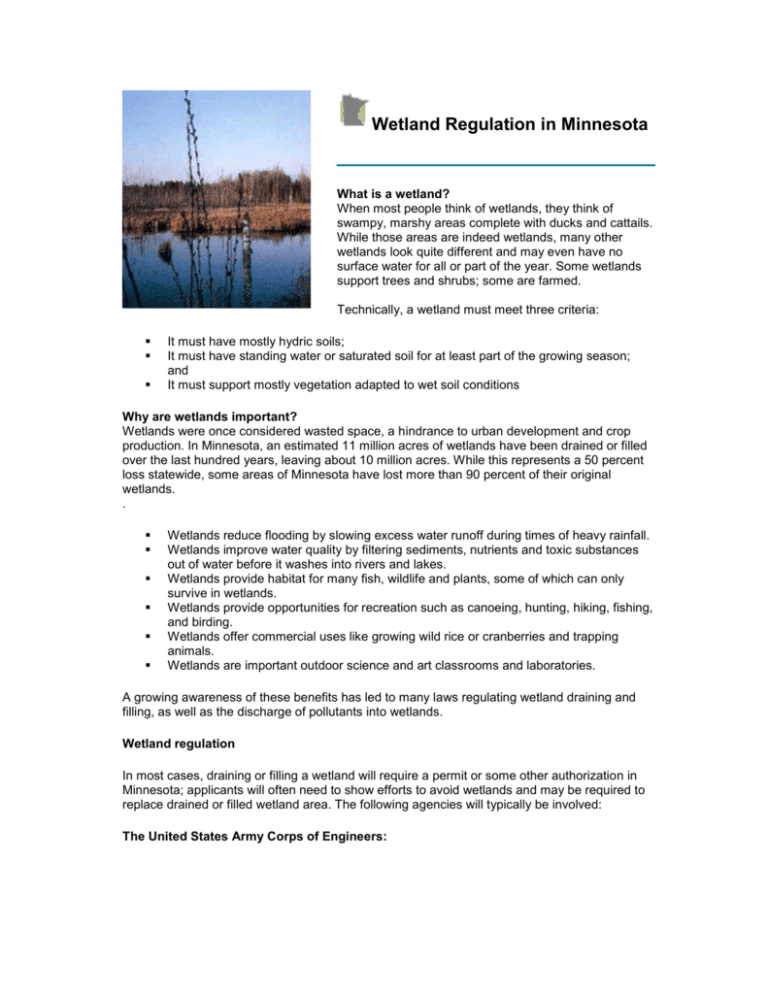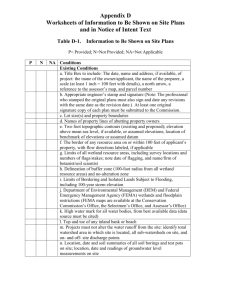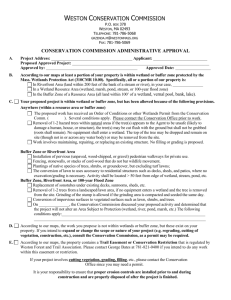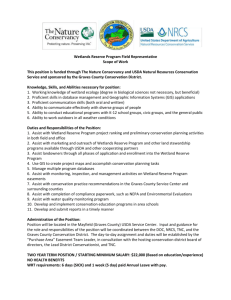Wetland Regulation in Minnesota
advertisement

Wetland Regulation in Minnesota What is a wetland? When most people think of wetlands, they think of swampy, marshy areas complete with ducks and cattails. While those areas are indeed wetlands, many other wetlands look quite different and may even have no surface water for all or part of the year. Some wetlands support trees and shrubs; some are farmed. Technically, a wetland must meet three criteria: It must have mostly hydric soils; It must have standing water or saturated soil for at least part of the growing season; and It must support mostly vegetation adapted to wet soil conditions Why are wetlands important? Wetlands were once considered wasted space, a hindrance to urban development and crop production. In Minnesota, an estimated 11 million acres of wetlands have been drained or filled over the last hundred years, leaving about 10 million acres. While this represents a 50 percent loss statewide, some areas of Minnesota have lost more than 90 percent of their original wetlands. . Wetlands reduce flooding by slowing excess water runoff during times of heavy rainfall. Wetlands improve water quality by filtering sediments, nutrients and toxic substances out of water before it washes into rivers and lakes. Wetlands provide habitat for many fish, wildlife and plants, some of which can only survive in wetlands. Wetlands provide opportunities for recreation such as canoeing, hunting, hiking, fishing, and birding. Wetlands offer commercial uses like growing wild rice or cranberries and trapping animals. Wetlands are important outdoor science and art classrooms and laboratories. A growing awareness of these benefits has led to many laws regulating wetland draining and filling, as well as the discharge of pollutants into wetlands. Wetland regulation In most cases, draining or filling a wetland will require a permit or some other authorization in Minnesota; applicants will often need to show efforts to avoid wetlands and may be required to replace drained or filled wetland area. The following agencies will typically be involved: The United States Army Corps of Engineers: Work in any wetland or water area generally requires a permit from the United States Army Corps of Engineers regardless of whether other state, local, or U.S. Department of Agriculture Natural Resources Conservation Service permits are required. You may contact the United States Army Corps of Engineers St. Paul office at 651-290-5375; TTY 800/290-5858; or consult its web site at http://www.mvp.usace.army.mil. (Click on the Corps Permits button). The United States Fish and Wildlife Service and the State Historic Preservation Officer review United States Army Corps of Engineers permit applications for their impact on cultural resources and federal endangered species. Applicants are encouraged to contact the United States Fish and Wildlife Service and the State Historic Preservation Officer early in project planning to avoid later permit delays. The United States Fish and Wildlife Service can be reached at 612-725-3548, or check its website at http://www.fws.gov/r3pao/eco_serv/endangrd/lists/mi nnesot.html. The State Historic Preservation Officer can be reached at 651-296-5434. The Minnesota Department of Natural Resources: The Department of Natural Resources administers the Public Waters Work Permit Program on certain lakes, watercourses and wetlands in Minnesota. To determine whether a particular wetland is regulated by the Department of Natural Resources, contact the Department of Natural Resources hydrologist in the Department of Natural Resources regional office closest to the wetland area (this number is listed in the government section of the phone book). If you cannot find the number, you may call the main Department of Natural Resources office at 651/296-6157 in the Twin Cities; toll-free at 888-646-6367 (888MINNDNR); TTY 651-296-5484 in the Twin Cities; toll-free TTY 800-657-3929. This information is also available at the web site address http://www.dnr.state.mn.us/waters/resources/index.html. Local governments: Minnesota's Wetland Conservation Act regulates wetland draining and filling activities on all wetlands not covered by the Department of Natural Resource's Public Waters Work Permit Program. Although the Minnesota Board of Water and Soil Resources administers the Wetland Conservation Action on a statewide basis, local governments-including cities, counties, townships, soil and water conservation districts, and watershed management organizations--implement the Wetland Conservation Action locally. Local governments may also have their own wetland ordinances. To find out who carries out the Wetland Conservation Action in your area, contact your county soil and water conservation district --listed in the government section of the phone book-- or the main office of the Board of Water and Soil Resources (651-296-3767; TTY users can call 800-627-3529). Agencies that have some jurisdiction over wetlands but generally need not be contacted directly by landowners include: The United States Department of Agriculture Natural Resources Conservation Service: Under stipulations contained in the Federal Agricultural Improvement and Reform Act, a landuser who alters a wetland for agricultural purposes loses eligibility for many United States Department of Agriculture benefits including the Conservation Reserve Program, federal farm loans, price support programs, etc. Farmers should contact the United States Department of Agriculture Natural Resources Conservation Service prior to any drainage activity. Potential agricultural land buyers should also contact Natural Resources Conservation Service to check for the presence of wetlands. Please contact your local Natural Resources Conservation Service office, listed under the United States government in the telephone directory; or the Natural Resources Conservation Service state office at 651-602-7900; TTY 651-602-7859. The Minnesota Pollution Control Agency: United States Army Corps of Engineers permits are not valid unless the Minnesota Pollution Control Agency has certified that the project will comply with state water quality standards. This certification is handled by the two agencies as part of the United States Army Corps of Engineers permit review process; applicants generally do not need to contact the Minnesota Pollution Control Agency directly. The Minnesota Pollution Control Agency also regulates the discharge of pollutants, including stormwater, into wetlands. Wetland Violations The Enforcement Division of the Department of Natural Resources enforces most of Minnesota's wetland regulations. People with concerns that specific wetland draining or filling activities occurring in their area may be unauthorized should contact their local Department of Natural Resources conservation officer and the United States Army Corps of Engineers. Phone numbers for conservation officers are available by calling 651-296-6157 in the Twin Cities; or toll-free at 888-646-6367. The United States Army Corps of Engineers number is 651-290-5375. If you have a project that might affect a wetland: Early in the process, contact your county soil and water conservation district, listed in the government section of the phone book. The soil and water conservation district should be able to give you appropriate guidance. Find out if the land you want to alter is a wetland. Remember, an area can be a wetland even if it does not appear wet on the surface. Your soil and water conservation district will either help you make this determination or direct you appropriately. Fill out a Combined Project Application form. You will need to mail copies of this form to all agencies listed on the form. This form is available from your soil and water conservation district, on the internet at http://www.bwsr.state.mn.us/test3/wetlands/index.html or by calling the Minnesota Board of Water and Soil Resources at 651-296-3767. You should hear back from the agencies after mailing the Combined Project Application form. If you do not, contact them before beginning work. Advice for project applicants Begin early! Visit your soil and water conservation district office and fill out the Combined Project Application form as soon as possible. Before you purchase property for development, consider the existence of any wetlands and weigh the environmental impact and financial cost of disturbing those areas against the project's benefits. Be aware of state, federal and local regulations. If you proceed with a project, determine where the wetlands are and design your project accordingly. Thoroughly consider and document the alternatives you have considered to avoid wetland impacts. Consider the possible concerns of the community and the project's neighbors and involve them early in the process. Provide truthful and complete descriptions of all relevant project components.







